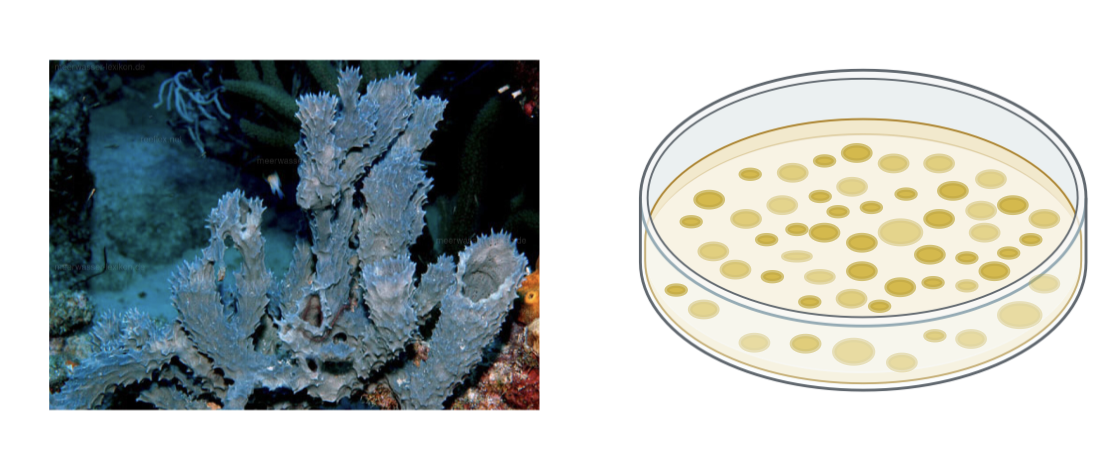Bioactive Alkaloids from Callyspongia sp.: A Marine Source of Antibacterial Agents Against Drug-Resistant Echerichia coli
Main Article Content
Abstract
This study investigated the antibacterial potential of secondary metabolites from the Indonesian marine sponge Callyspongia sp. against antibiotic-resistant Escherichia coli. Conducted between November 2017 and January 2018, the research involved extraction, isolation, and characterization of bioactive compounds at Syiah Kuala University’s Marine Chemistry, Microbiology, and Instrumentation Laboratories. Isolation was guided by bioactivity, using chromatographic techniques. FTIR spectral analysis identified functional groups indicative of alkaloids, with imine (C=N) absorption at 1637.4 cm⁻¹ and fingerprint confirmation at 1407.2 cm⁻¹. Bioactivity testing showed inhibition zones of 7 mm and 8.25 mm at concentrations of 20 µg/mL and 100 µg/mL, respectively. The positive control, chloramphenicol (35 µg/mL), exhibited a 7.5 mm inhibition zone. These findings suggest that alkaloid compounds from Callyspongia sp. possess promising antibacterial activity comparable to conventional antibiotics. This highlights the potential of Callyspongia sp. as a source of novel antibacterial agents against resistant bacterial strains.
Article Details

This work is licensed under a Creative Commons Attribution 4.0 International License.
References
1. Diarrhoeal disease. World Health Organization: https://www.who.int/news-room/fact-sheets/detail/diarrhoeal-disease (accessed on 15 April 2025).
2. E. coli. World Health Organization: https://www.who.int/news-room/fact-sheets/detail/e-coli (accessed on 18 April 2025).
3. Álvarez-Martínez, F.J.; Barrajón-Catalán, E.; Micol, V. Tackling antibiotic resistance with compounds of natural origin: A comprehensive review. Biomedicines 2020, 8(10), p.405.
4. Varijakzhan, D.; Loh, J.Y.; Yap, W.S.; Yusoff, K.; Seboussi, R.; Lim, S.H.E.; Lai, K.S.; Chong, C.M. Bioactive compounds from marine sponges: Fundamentals and applications. Marine drugs 2021, 19(5), p.246.
5. de Sousa, L.H.N.; de Araújo, R.D.; Sousa-Fontoura, D.; Menezes, F.G.; Araújo, R.M. Metabolities from marine sponges of the genus Callyspongia: Occurrence, biological activity, and NMR data. Marine Drugs 2021, 19(12), p.663.
6. Poirel, L.; Madec, J.Y.; Lupo, A.; Schink, A.K.; Kieffer, N.; Nordmann, P.; Schwarz, S. Antimicrobial resistance in Escherichia coli. Microbiology spectrum 2018,6(4), pp.10-1128.
7. Laport, M.S.; Santos, O.C.S.; Muricy, G. Marine sponges: potential sources of new antimicrobial drugs. Current pharmaceutical biotechnology 2009,10(1), pp.86-105.
8. Elissawy, A.M.; Soleiman Dehkordi, E.; Mehdinezhad, N.; Ashour, M.L.; Mohammadi Pour, P. Cytotoxic alkaloids derived from marine sponges: A comprehensive review. Biomolecules 2021, 11(2), p.258.
9. Hancock, R.E.; Haney, E.F.; Gill, E.E. The immunology of host defence peptides: beyond antimicrobial activity. Nature Reviews Immunology 2016, 16(5), pp.321-334.
10. Alksne, L.E.; Projan, S.J. Bacterial virulence as a target for antimicrobial chemotherapy. Current opinion in Biotechnology 2000, 11(6), pp.625-636.
11. Hong, L.L.; Ding, Y.F.; Zhang, W.; Lin, H.W. Chemical and biological diversity of new natural products from marine sponges: a review (2009–2018). Marine Life Science & Technology 2022, 4(3), pp.356-372.
12. Bian, C.; Wang, J.; Zhou, X.; Wu, W.; Guo, R. Recent advances on marine alkaloids from sponges. Chemistry & Biodiversity 2020, 17(10), p.e2000186.
13. Mbah, J.A.; Ngemenya, M.N.; Abawah, A.L.; Babiaka, S.B.; Nubed, L.N.; Nyongbela, K.D.; Lemuh, N.D.; Efange, S.M. Bioassay-guided discovery of antibacterial agents: in vitro screening of Peperomia vulcanica, Peperomia fernandopoioana and Scleria striatinux. Annals of Clinical Microbiology and Antimicrobials 2012, 11, pp.1-10.

